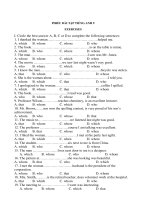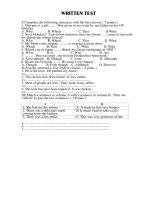unit 2 clothing 1 choose a b c or d to complete the following sentences 1 clothes do you prefer t shirt or pullover a what b how c which d where 2 my uncle was a he has a large collection of music
Bạn đang xem bản rút gọn của tài liệu. Xem và tải ngay bản đầy đủ của tài liệu tại đây (23.57 KB, 3 trang )
<span class='text_page_counter'>(1)</span><div class='page_container' data-page=1>
<b>UNIT 2: CLOTHING</b>
<b>1. Choose A, B, C or D to complete the following sentences.</b>
1<b>.</b> ……….. clothes do you prefer, T.shirt or pullover?
A. What B. How C. Which D. Where
2. My uncle was a ……… . He has a large collection of musical instruments.
A. music B. musical C. musically D. musician
3. Vietnamese women prefer to wear modern clothing……… work.
A. at B. in C. to D. with
4. Peter got ……… quickly and went to school.
A. dress B. dressed C. dressing D. dresses
5.It’s ……… to call anyone at night.
A. convenience B. inconvenience C. convenient D.
inconvenient
6.The Ao dai is the ……….. dress of Vietnamese women.
A. beautiful B. traditional C. casual D. baggy
7. ……… have fashion designers done to modernize the Ao dai?
A. How B. What C. Why D. Where
8. The word Jeans comes………..a kind of material that was made in Europe.
A. in B. at C. from D. on
9. The national dress of Japanese women is ………
A.Kimono B. Ao dai C. Sari D. Jeans
10. Nguyen Du is considered a famous Vietnamese ……….
A. peotry B. poem C. poet D. poetic
11. Mary ………….. write to me last year.
A. uses to B. used to C. is used to D. was used
to
12. She describes herself ……… a fashion designer.
A. by B. as C. in D. from
13. He ……… with friends in an apartment in HCMC since last week.
A. living B. has lived C. lived D. live
14. I wish you ………. here tomorrow.
A. come B. came C. will come D. would
come
15. I ……… English here since I graduated from university.
A. teach B. taught C. have taught D. am
</div>
<span class='text_page_counter'>(2)</span><div class='page_container' data-page=2>
16. Wearing uniform helps students ……… equal in many.
A. fall B. feel C. fell D. felt
17. It’s dangerous ……… in this river.
A. swim B. to swim C. swimming D. swam
18. Millions of Christmas cards ……… last month.
A. were sent B. sent C.send D. are
sent
19. Marie Curie ……… the Nobel Prize for Physics in 1903.
A. award B. awarded C. was awarded D. has
awarded
20. He hates being ……….. at.
A. look B. looking C. to look D. looked
<b>2. Choose A, B, C or D to complete the following passage:</b>
CLOTHES
Clothes can tell a lot (1) ……….. a person. Some people like very
colorful clothes because they want everyone (2) ……… at them and
they want to be the center of things. (3) ……… people like to wear nice
clothes, but their clothes are not (4) ………. Of fancy. They do not like
people (5) ………. . Clothes today are very different (6)
………. the clothes of the 1800s. One different way they look. For
example, in the 1800s, all women (7)……… dress. The dresses all had
long skirts. But today, women do not always wear dresses with long skirts.
Sometimes they wear short skirts. Sometimes they wear pants. Another
difference between 1800 and today is the (8)……… . In the 1800s,
clothes (9)……….natural kinds of cloth. They were made from cotton,
wool, silk or linen. But today, there are (10)……… kinds of man made
cloth. A lot of clothes are now made from nylon, rayon or polyester.
1. A. about B. at C. with D. on
2. A. look B. to look C. looked D. looking
3. A. each other B. another C. others D. other
4. A. color B. colorfully C. colorful D. colored
5. A. to look at them B. to looking at them
C. looking at them D. looked at them
6. A. at B. to C. from D. in
7. A. wear B. worn C. wore D. wearing
8. A.. cloth B. clothing C. clothe D. clothes
</div>
<span class='text_page_counter'>(3)</span><div class='page_container' data-page=3></div>
<!--links-->









